Study guides, Class notes & Summaries
Looking for the best study guides, study notes and summaries about ? On this page you'll find 106 study documents about .
Page 3 out of 106 results
Sort by
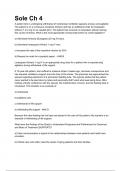
-
Sole Ch 4 Complete Questions and Answers A+ RATED
- Exam (elaborations) • 10 pages • 2024
-
- $14.39
- + learn more
Sole Ch 4 Complete Questions and Answers A+ RATED A patient who is undergoing withdrawal of mechanical ventilation appears anxious and agitated. The patient is on a continuous morphine infusion and has an additional order for lorazepam (Ativan) 1 to 2 mg IV as needed (prn). The patient has received no lorazepam (Ativan) during this course of illness. What is the most appropriate nursing intervention to control agitation? a) Administer fentanyl (Duragesic) 25 mg IV bolus. b) Administer lo...
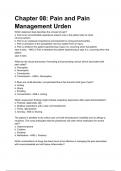
-
Chapter 08: Pain and Pain Management Urden
- Exam (elaborations) • 5 pages • 2024
-
- $14.39
- + learn more
Chapter 08: Pain and Pain Management Urden Which statement best describes the concept of pain? a. Pain is an uncomfortable experience present only in the patient with an intact nervous system. b. Pain is an unpleasant experience accompanied by crying and tachycardia. c. Pain is activation of the sympathetic nervous system from an injury. d. Pain is whatever the patient experiencing it says it is, occurring when that patient says it does. - ANS d. Pain is whatever the patient experiencing ...
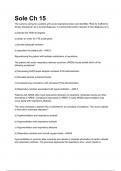
-
Sole Ch 15 Complete Questions and Answers A+ GRADED
- Exam (elaborations) • 13 pages • 2024
-
- $13.48
- + learn more
Sole Ch 15 Complete Questions and Answers A+ GRADED The nurse is caring for a patient with acute respiratory failure and identifies "Risk for Ineffective Airway Clearance" as a nursing diagnosis. A nursing intervention relevant to this diagnosis is to a) elevate the HOB 30 degrees b) obtain an order for VTE prophylaxis c) provide adequate sedation d) reposition the patient q2h - ANS D Repositioning the patient will facilitate mobilization of secretions. The patient with acut...
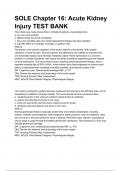
-
SOLE Chapter 16: Acute Kidney Injury TEST BANK Complete Questions and Answers A+
- Exam (elaborations) • 24 pages • 2024
-
- $14.48
- + learn more
SOLE Chapter 16: Acute Kidney Injury TEST BANK Complete Questions and Answers A+ The critical care nurse knows that in critically ill patients, renal dysfunction a. is a very rare problem. b. affects nearly two thirds of patients. c. has a low mortality rate once renal replacement therapy has been initiated. d. has little effect on morbidity, mortality, or quality of life. ANS: B The kidney is the primary regulator of the body's internal environment. With sudden cessation of renal funct...
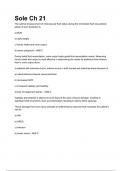
-
Sole Ch 21 Complete Questions and Answers A+
- Exam (elaborations) • 12 pages • 2024
-
- $14.48
- + learn more
Sole Ch 21 Complete Questions and Answers A+ The optimal measurement of intravascular fluid status during the immediate fluid resuscitation phase of burn treatment is a) BUN b) daily weight c) hourly intake and urine output d) serum potassium - ANS C During initial fluid resuscitation, urine output helps guide fluid resuscitation needs. Measuring hourly intake and output is most effective in determining the needs for additional fluid infusion than is urine output alone. In pat...
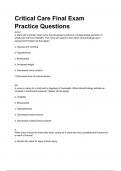
-
Critical Care Final Exam Practice Questions and Answers A+ RATED
- Exam (elaborations) • 68 pages • 2024
-
- $14.48
- + learn more
Critical Care Final Exam Practice Questions and Answers A+ RATED a,d,e,f A client with a primary brain tumor has developed syndrome of inappropriate secretion of antidiuretic hormone (SIADH). The nurse will expect to see which clinical findings upon assessment? (Select all that apply). a. Nausea and vomiting b. Hyperthermia c. Bradycardia d. Increased weight e. Decreased serum sodium f. Decreased level of consciousness a,b A nurse is caring for a child with a diagnosis ...
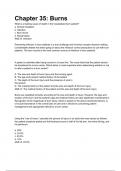
-
Chapter 35: Burns Complete Questions and Answers A+
- Exam (elaborations) • 13 pages • 2024
-
- $14.48
- + learn more
Chapter 35: Burns Complete Questions and Answers A+ What is a leading cause of death in the hospitalized burn patient? a. Smoke inhalation b. Infection c. Burn shock d. Renal failure ANS: B. Infection Preventing infection in burn patients is a true challenge and involves complex decision making. Considerable debate has been going on about the infection control precautions to use with burn patients. The burn wound is the most common source of infection in burn patients. A patient ...
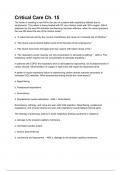
-
Critical Care Ch. 15 Complete Questions and Answers A+
- Exam (elaborations) • 5 pages • 2024
-
- $14.48
- + learn more
Critical Care Ch. 15 Complete Questions and Answers A+ The nurse is orienting a new RN in the care of a patient with respiratory distress due to emphysema. The patient is being treated with O2 via a Venturi mask with 35% oxygen. Which statement by the new RN indicates that teaching has been effective, when the nurse questions the new RN about the use of the Venturi mask? a. "A nasal cannula will dry the mucous membranes and cause an increased risk of infection." b. "Her alveoli cannot...
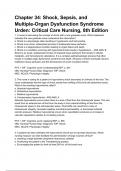
-
Chapter 34: Shock, Sepsis, and Multiple-Organ Dysfunction Syndrome Urden: Critical Care Nursing, 8th Edition Complete Questions and Answers A+
- Exam (elaborations) • 12 pages • 2024
-
- $13.48
- + learn more
Chapter 34: Shock, Sepsis, and Multiple-Organ Dysfunction Syndrome Urden: Critical Care Nursing, 8th Edition Complete Questions and Answers A+ 1. A nurse is discussing the concept of shock with a new graduate nurse. Which statement indicates the new graduate nurse understood the information? a. Shock is a physiologic state resulting in hypotension and tachycardia. b. Shock is an acute, widespread process of inadequate tissue perfusion. c. Shock is a degenerative condition leading to organ fa...
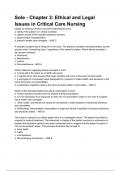
-
Sole - Chapter 3: Ethical and Legal Issues in Critical Care Nursing
- Exam (elaborations) • 5 pages • 2024
-
- $13.48
- + learn more
Sole - Chapter 3: Ethical and Legal Issues in Critical Care Nursing Ideally, an advance directive should be developed by the a. family if the patient is in critical condition. b. patient as part of the hospital admission process. c. patient before hospitalization. d. patient's health care surrogate. - ANS C A critically ill patient has a living will in the chart. The patient's condition has deteriorated, but the spouse wants "everything done," regardless of the patient's wishes. Whi...

How much did you already spend on Stuvia? Imagine there are plenty more of you out there paying for study notes, but this time YOU are the seller. Ka-ching! Discover all about earning on Stuvia


